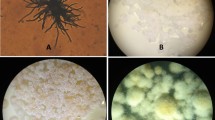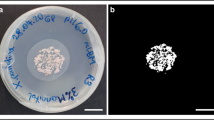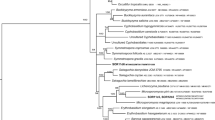Abstract
The growth of lichens in the field is slow and their cultivation is generally thought to be difficult. We studied the effects of environmental conditions and culture solutions on the growth of a lichen, and found that growth ofParmotrema tinctorum (Nyl.) Hale in growth cabinets was possible. The thallus area increased by about 20% monthly when the lichen was soaked in a culture solution for 90 min every four days and then grown at 100% relative humidity when the temperature in the growth cabinet was 20C and illumination was at 12 W/m2 for 16 hr daily.
Similar content being viewed by others
References
Ahmadjian, V. 1993. The Lichen Symbiosis. John Wiley and Sons, New York, p. 116.
Armstrong R.A. 1976. The influence of the frequency of wetting and drying on the radial growth of three saxicolous lichens in the field. New Phytol. 77: 719–724.
Armstrong, R.A. 1977. The response of lichen growth to additions of distilled water, rainwater and water from a rock surface. New Phytol.79: 373–376.
Denison, W.C. 1988. Culturing the lichensLobaria oregana andL. pulmonaria on nylon monofilament. Mycologia80: 811–814
Dibben, M.J. 1971. Whole-lichen culture in a phytotron. Lichenologist5: 1–10.
Furusawa, I. 1989. Manual of Plant Pathological Experiments. Yokendo, Tokyo, p. 146. (in Japanese)
Holm-Hansen, O., Gerloff, G.C. andSkoog, F. 1954. Cobalt as an essential element for blue-green algae. Physiol. Plant.7: 665–675.
Okuno, H. andNakano, N. 1966. Handbook of Inorganic and Analytical Experiments. Tokyo Kagaku Dojin, Tokyo, p. 211. (in Japanese)
Pearson, LC. 1970. Varying environmental factors in order to grow intact lichens under laboratory conditions. Amer. J. Bot.57: 659–664.
Smith, D.C. 1960a. Studies in the physiology of lichens. I. The effects of starvation and of ammonia absorption upon the nitrogen content ofPeltigera polydactyla. Ann. Bot.24: 52–62.
Smith, D.C. 1960b. Studies in the physiology of lichens. 2. Absorption and utilization of some simple organic nitrogen compounds byPeltigera polydactyla. Ann. Bot.24: 172–185.
Smith, D.C. 1960c. Studies in the physiology of lichens. 3. Experiments with dissected discs ofPeltigera polydactyla. Ann. Bot.24: 186–199.
Sugino, M. andAshida, K. 1990. Growth of umenokigoke,Parmelia tinctorum Nyl., under field and experimental conditions. Report of Environmental Science Institute, Kinki University18: 69–76 (in Japanese)
Yamamoto, Y., Mizuguchi, R. andYamada, Y. 1985. Tissue culture ofUsnea rubescens andRamalina yasudae and production of usnic acid in their cultures. Agric. Biol. Chem.49: 3347–3348.
Yamamoto, Y., Mizuguchi, R., Takayama, S. andYamada, Y. 1987. Effects of culture conditions on the growth of Usneaceae lichen tissue cultures. Plant Cell Physiol.28: 1421–1426.
Author information
Authors and Affiliations
Rights and permissions
About this article
Cite this article
Bando, M., Sugino, M. Cultivation of the lichenParmotrema tinctorum in growth cabinets. J. Plant Res. 108, 53–57 (1995). https://doi.org/10.1007/BF02344305
Received:
Accepted:
Issue Date:
DOI: https://doi.org/10.1007/BF02344305




